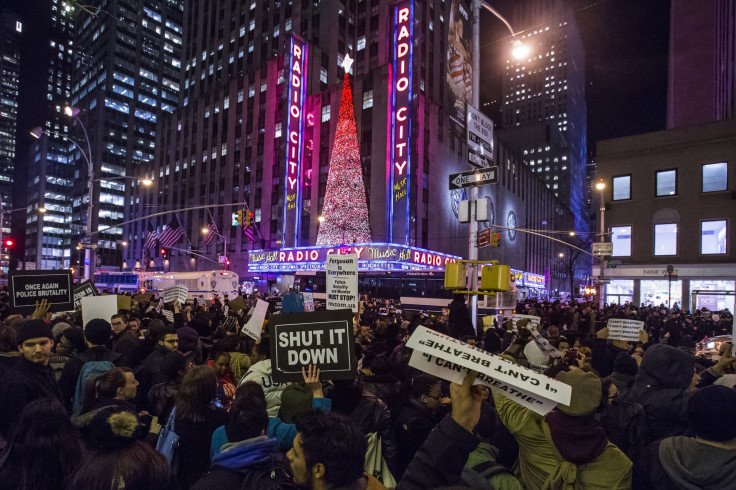
The “Christmas in Rockefeller Center” celebration was meet with some resistance last night. The 82nd annual event was well attended with thousands of New Yorkers and tourists awaiting the famous tree lighting, and NBC presented holiday concerted. However not all in attendance were there for the festivities, people chanted “shut it down” while protesting the death of Staten Island native Eric Garner, who died during an arrest in July of 2014. The New York City grand jury decision was announced subsequently on the same as the tree lighting, which revealed that the jury decided not to charge NYPD officer Daniel Pantaleo for the death of Garner.
Garner, a 43-year-old father of six, was accused of illegally selling cigarettes on a sidewalk when Pantaleo put him in a chokehold from behind and tackled him with the help of other officers. Police said he had resisted arrest. The news immediately sparked a new wave of protests, which have become frequent occurrences in New York City since the grand jury decision in the death of unarmed teen Michael Brown in Ferguson, Missouri. However the protests seemed misplaced at the holiday celebration, which has a surprisingly long and storied history. Today, the “Christmas In Rockefeller Center” show is a multi-million dollar extravaganza featuring performances, TODAY hosts, thousands of tourists of course Christmas lights, however the event has humble and meaningful beginnings.
The tree lighting tradition began on Christmas Eve in 1931 in the midst of America’s Great Depression. The first ever Rockefeller Christmas tree was erected by a group of construction workers, a 20 foot Christmas tree was placed in the middle of the muddy and dilapidated site that would become the grand Rockefeller Plaza we know today. The creation, even mired in the debt of the Depression, would become one of New York City’s greatest architectural and commercial monuments. In the face of the great depression, the men at the construction site had a grand cause to celebrate on this December 24th because they were about to be paid for their efforts, unlike most of their other colleagues, friends and family. Underneath the first ever Rockefeller Christmas Tree, a clerk sat on a wooden crate and handed out checks to grateful workers. A tree lighting ceremony did not occur, mainly because the tree was adorned with tin cans and scrap paper but only two years later in 1933 the first official ceremony was decreed when a Rockefeller Center publicist organized it.
The tree at Rockefeller Center even served as a symbol during World War II, in 1942; three small trees decorated in ornaments of red, white and blue were placed in the plaza. The trees were replanted following the Christmas season, as per orders of the organizers. In 1944, still wartime, Rockefeller Center and their famous Christmas trees had to keep in line with blackout regulations, meaning that the trees remained unlit. In 1945, in a celebration of the end of World War II and the end of blackout restrictions, the Rockefeller Center organizers employed the use of six ultraviolet light projectors to make all 700 fluorescent globes on that year's tree glow brightly even in the dark.
Shutting down “Christmas in Rockefeller Center” is not going to make a change in the recent racial tension that has struck the United States. Instead the protests sully a long tradition of celebrating togetherness and hope when facing despair and anguish.
© 2025 Latin Times. All rights reserved. Do not reproduce without permission.





